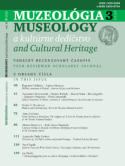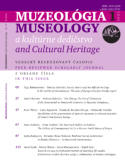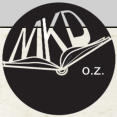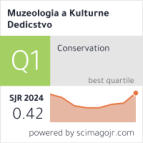

MUZEOLÓGIA
MUSEOLOGY
a kultúrne dedičstvo
and Cultural Heritage

News
Journal Muzeológia a
kultúrne dedičstvo -
Museology and Cultural
Heritage:
SJR 2024: 0,424 (Q1)
Museology SJR rank: 8/83 (Q1) Conservation SJR rank: 11/103 (Q1)JIF WoS 2023: 0,6
JCI WoS 2023: 1,28, Q1 ESCI: 49/411 (Q1)New issue
Muzeológia a kultúrne
dedičstvo 2/2025
online New volume Studia Museologica Slovaca, vol. 8 (2024) online New volume Populačné štúdie Slovenska 17 (2024) onlineNew book
P. Tišliar (ed.). Osobnosti uměleckoprůmyslového muzejnictví (2025) online
Contents 1/2025
Title: Sound, silence and the difficult heritage in the realms of remembrance: The case of Europe and
Asia–Pacific region
Abstract: This article addresses the role of sound and silence in different types of memorials – monuments, memorials and museums.
It shows how silence plays an important role which can be pierced by a sudden resounding sound – be it a whisper or the ringing of a
bell, or oil coming out of a wreck. The authors focused their analysis on memorials in the Asia-Pacific region, Europe and Israel, which
are inextricably linked to a difficult heritage. The aim of using sound in a space commemorating tragic events is to appeal to the
visitor’s emotions, as well as to create a specific narrative.
Authors: Olga Barbasiewicz,1 Marcin Zaborski2
Publication order reference:
1 SWPS University, Warsaw, Poland, e-mail: obarbasiewicz@swps.edu.pl, https://orcid.org/0000-0002-3826-2538
2 SWPS University, Warsaw, Poland, e-mail: mzaborski@swps.edu.pl, https://orcid.org/0000-0001-9746-9670
Source: Muzeológia a kultúrne dedičstvo, year: 2025, vol.: 13, issue: 1, pages: 5–26.
Key words: memorials, Pearl Harbor, Holocaust, Japan, Israel
Language: English
online full-text PDF
doi: 10.46284/mkd.2025.13.1.1
Title: The Art of Chinoiserie of the Seventeenth to Nineteenth Centuries in Museum Complexes of
Ukraine
Abstract: This article discusses the features of manifestations of the Chinoiserie style in Ukraine. The study focuses on architectural
and artistic monuments of the seventeenth to nineteenth centuries, with an emphasis on interior design and garden art. The article
outlines the routes of penetration of Chinese handicrafts and objects of the European Chinoiserie style and identifies the leading
motifs and elements that were used in organising the subject-spatial environment of Ukrainian estates: mural painting, porcelain,
furniture, park sculpture and small-scale architecture. With reference to a generalisation of the authors’ field investigation results, the
article outlines features of the use of elements of Chinoiserie style and their adaptation to local landscapes and cultural contexts. The
main observations and conclusions of the study were obtained using methods of figurative–stylistic, formal, semantic and comparative
analyses.
Authors: Andrii Korniev,1 Svitlana Rybalko,2 Zhe Zhang3
Publication order reference:
1 Kharkiv State Academy of Design and Arts, Department of Theory and History of Art, Ukraine, e-mail: andriikor66@gmail.com, https://orcid.org/0000-0002-
0016-6954
2 Kharkiv State Academy of Culture, Department of Art Studies, Ukraine, e-mail: rybalko.svetlana62@gmail.com, https://orcid.org/0000-0001-5873-2421
3 Hebei Academy of Fine Arts, Shijiazhuang, Hebei province, PR China, e-mail: 936711637@qq.com, https://orcid.org/0000-0002-2279-3967
Source: Muzeológia a kultúrne dedičstvo, year: 2025, vol.: 13, issue: 1, pages: 27–45.
Keywords: Chinoiserie style, architectural and arts ensembles of Ukraine, interior design, garden art, porcelain manufacture in
Ukraine
Language: English
online full-text PDF
doi: 10.46284/mkd.2025.13.1.2
Title: Specificities of the presentation of open-air museums in selected countries of Central and
Eastern Europe
Abstract: The article analyses the idea of open-air museums in selected countries of Central and Eastern Europe while aiming to
identify and name the varied focus and specificities of their presentations. These institutions typically combine two concepts: the
monument concept, which relates to the protection and presentation of architecture, and the museological concept, which includes the
“revival” of these sites through presentation and educational means. A living museum, living history, presenting everyday life, crafts,
handcrafts, agricultural work, but also revived technological and military objects, have an inestimable place in the system of modern
museum culture.
Author: Pavol Tišliar,1 Lucie Jagošová,2 Dominika Kuśnierz-Krupa,3 Oleksandr Ivashko4
Publication order reference:
1 Masaryk University, Faculty of Arts, Department of Archaeology & Museology, Czech Republic, e-mail: tisliar@phil.muni.cz, https://orcid.org/0000-0002-0886-
7499
2 Masaryk University, Faculty of Arts, Department of Archaeology & Museology, Czech Republic, e-mail: jagosova@phil.muni.cz, https://orcid.org/0000-0002-
3436-7404
3 Cracow University of Technology, Faculty of Architecture, Poland, e-mail: dominika.kusnierz-krupa@pk.edu.pl, https://orcid.org/0000-0003-1678-4746
4 Kyiv National University of Construction and Architecture, Ukraine, e-mail: ghok2233@gmail.com, https://orcid.org/0000-0002-9194-2153
Source: Muzeológia a kultúrne dedičstvo, year: 2025, vol.: 13, issue: 1, pages: 47–66.
Keywords: open-air museums, open-air ethnographic expositions, Central and Eastern Europe
Language: English
online full-text PDF
doi: 10.46284/mkd.2025.13.1.3
Title: The Starmach Gallery in Kraków: The Gallery of Contemporary Art in a Former Jewish House of
Prayer
Abstract: The adaptation of the former Jewish Zucker House of Prayer as a gallery of contemporary art is a unique phenomenon due
to both the complicated history of the heritage building itself and the unique personality of the current owner. Andrzej Starmach, an art
dealer and collector in one, has gathered an extraordinary collection of contemporary Polish art, managing to stay ahead of popular
trends. For many years, the Starmach Gallery was a lone beacon of culture in the run-down Podgórze district, which is now
flourishing, becoming a location of numerous museums. Through their recent donation of their outstanding collection of Polish
contemporary art – built up over a period of many years – to the city of Kraków, Andrzej and Teresa Starmach have left their mark on
the history of Polish art collecting.
Authors: Anna Jasińska,1 Artur Jasiński2
Publication order reference:
1 Museum of Jagiellonian University, 15, Jagiellońska Street, 31-010 Kraków, Poland, e-mail: anna.jasinska.krakow@gmail.com, https://orcid.org/ 0000-0002-
4769-4340
2 Andrzej Frycz Modrzewski Kraków University, Department of Architecture and Fine Arts, 1, Gustawa Herlinga-Grudzińskiego Street, 30-750 Kraków, Poland,
e-mail: artur.jasinski@ajbiuro.pl, https://orcid.org/ 0000-0002-5285-8143
Source: Muzeológia a kultúrne dedičstvo, year: 2025, vol.: 13, issue: 1, pages: 67–86.
Keywords: Polish contemporary art, collecting, heritage, memory, adaptive reuse
Language: English
online full-text PDF
doi: 10.46284/mkd.2025.13.1.4
Title: Medieval Sacral Architecture in Banská Štiavnica – Architectural Interpretation
Abstract: Knowledge about the architectural–historical development of medieval sacral buildings in Banská Štiavnica has gained
clearer contours in recent years thanks to many new findings from monument research and published studies that have been
processed in the last two decades. Based on these scientific documents, we have elaborated on the theoretical reconstructions of the
medieval architectural form of the churches and chapels of Banská Štiavnica from the thirteenth to the middle of the sixteenth century:
Romanesque churches and chapels: the Church of the Virgin Mary, the Chapel of St Michael and the monastery Church of St
Nicholas; Gothic churches and chapels: the Hospital Church of St Elizabeth of Hungary, the castle Chapel on Glanzenberg Hill, the
late Gothic church of Our Lady of the Snows, the Town Hall Chapel of St Anne and the Church of St Catherine. The authors connect
new knowledge with their recent research into the medieval residential development of the city.
Authors: Lýdia Budayová,1 Katarína Terao Vošková2
Publication order reference:
1Regional Monuments Board Nitra, Námestie Jána Pavla II., 8, 92701 Nitra, Slovakia, e-mail: budayova.lydia@gmail.com, https://orcid.org/0009-0006-7852-
0323
2 Slovak University of Technology in Bratislava, Faculty of Architecture and Design, Department of Theory and History of Architecture and Monuments
Preservation, Námesie slobody 19, 81245 Bratislava, Slovakia, e-mail: katarina.voskova@stuba.sk, https://orcid.org/0000-0002-7928-0791
Source: Muzeológia a kultúrne dedičstvo, year: 2025, vol.: 13, issue: 1, pages: 87–112.
Keywords: Banská Štiavnica, Middle Ages, sacral architecture, architectural interpretation, Gothic architecture
Language: English
online full-text PDF
doi: 10.46284/mkd.2025.13.1.5
Title: Towards an easy-to-implement method of obtaining 3D models of historical wooden churches
using a combination of modern techniques
Abstract: Modern 3D computer technologies allow for precise documentation of historic architectural objects by building digital 3D
models. For this purpose, 3D laser scanning techniques using terrestrial laser scanning (TLS) and photogrammetry are commonly
used. This article presents the use of both technologies for the 3D digitisation of historical wooden churches located in the Carpathian
Region in Romania. It describes the methodology used to obtain digital mesh 3D models of this type of objects, from the planning
stage, through the process of data acquisition in the field, to methods of data processing and integration of data from two different
technologies in order to improve the generated digital 3D models. Particular emphasis was placed on avoiding cost increases and
delays resulting from the need to use non-terrestrial data acquisition methods. The article presents the results of generating 3D
models on the example of Orthodox churches in the villages of Creaca, Păniceni, Târgușor and Păusa located in the Cluj region in
Transylvania. The results indicate that well-performed data integration allows for obtaining digital 3D models that will also be suitable
for dissemination.
Authors: Jacek Kęsik,1 Marek Miłosz,2 Jerzy Montusiewicz,3 Kamil Żyła4
Publication order reference:
1 Lublin University of Technology, Faculty of Electrical Engineering and Computer Science, Department of Computer Science, Nadbystrzycka 36B, PL-20-618
Lublin, Poland, e-mail: j.kesik@pollub.pl, https://orcid.org/0000-0002-2040-8172
2 Lublin University of Technology, Faculty of Electrical Engineering and Computer Science, Department of Computer Science, Nadbystrzycka 36B, PL-20-618
Lublin, Poland, e-mail: m.milosz@pollub.pl, https://orcid.org/0000-0002-5898-815X
3 Lublin University of Technology, Faculty of Electrical Engineering and Computer Science, Department of Computer Science, Nadbystrzycka 36B, PL-20-618
Lublin, Poland, e-mail: j.montusiewicz@pollub.pl, https://orcid.org/0000-0002-8571-3354
4 Lublin University of Technology, Faculty of Electrical Engineering and Computer Science, Department of Computer Science, Nadbystrzycka 36B, PL-20-618
Lublin, Poland, e-mail: k.zyla@pollub.pl, https://orcid.org/0000-0002-6291-003X
Source: Muzeológia a kultúrne dedičstvo, year: 2025, vol.: 13, issue: 1, pages: 113–137.
Keywords: historical wooden churches; 3D model; 3D scanning; TLS; photogrammetry
Language: English
online full-text PDF
doi: 10.46284/mkd.2025.13.1.6
Articles (Abstracts)

Full-text version
DOI:10.46284/mkd.2025.13.1.0
ISSN 1339-2204
eISSN 2453-9759
EV 1/22/EPP
Vol. 13 (2025), No. Is. 1



























